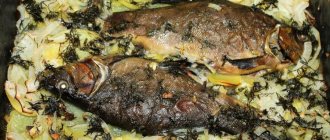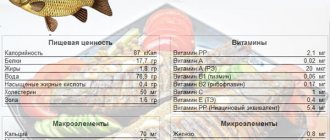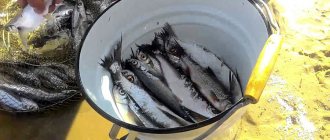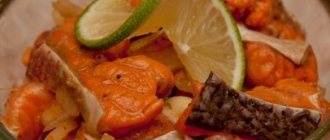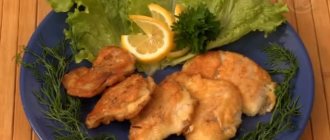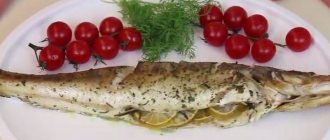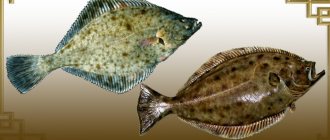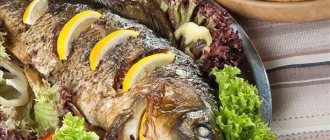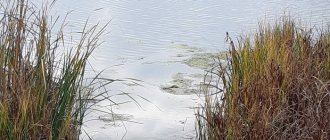Tench is a lazy fish with a sedentary lifestyle, which is advantageous to breed at home or grow in your own pond due to its omnivorous nature. People involved in its cultivation have a good income not only from direct sales, but also from providing services to anglers who want to fish in the reservoir. From the article you will learn about suitable places for growing tench, the characteristics of its behavior, feeding and spawning.
General characteristics and features
Tench is similar to its relatives from the carp family. It has a slightly short body, not too tall and thick. The fins are rounded, without sharp corners. The color is quite varied and varies depending on the place in which it lives. On the sandy bottom you can find fish that have a bronze or silver-olive tint. In reservoirs with a high amount of silt and peat, dark green and almost black individuals are found. The most common color is yellow sides with golden tints, green back and gray fins. The main distinguishing features are bright red small eyes and fleshy thick lips. The body is covered with small scales that adhere firmly to the skin and have a layer of mucus on top.
Due to its special appearance, tench is quite difficult to confuse with other types of fish, but it has several similar features with carp and crucian carp. Like carp, it has one antennae with supersensitive receptors in the corners of its mouth, and it also sucks up food particles from the bottom. But, unlike carp, tench are able to burrow into fairly deep layers of silt in search of food.
The similarity with crucian carp is that this fish is not picky about the amount of oxygen contained in the water column. For proper breathing, a concentration of 0.5-2 mg/l is enough. For this reason, in lakes and rivers that are completely frozen, only crucian carp and tench can survive, burrowing into the silt and hibernating. In this state, their metabolic processes slow down significantly; they require even less oxygen than in the warm season.
In the reservoirs of Russia, the average weight of tench is 200-700 g. In the middle zones of the country you can find individuals weighing up to 1-1.5 kg, the length of which is up to 30 cm. In rare cases, successful fishermen come across fish weighing 3-4 kg. The record was recorded in England: in 2001, a tench was caught there, weighing 6.89 kg.
Unlike most fish living in our country, tench has pronounced sexual characteristics. The pelvic fins of males are quite large, with strongly thickened rays. Females have a larger body, and they grow 30-40% faster.
Habitats
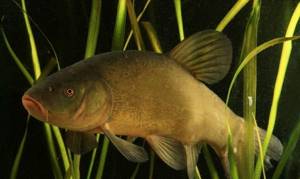
Tench is a typical freshwater inhabitant. It is found throughout the European part of Russia, Kazakhstan, east of the Urals and up to Baikal, Yenisei, Ob and even Turkey. The secretive and sedentary individual prefers such reservoirs. Where tench live, a calm current, a silted bottom, and an abundance of snags and aquatic plants prevail. Tench also prefers the moderate and warm climate of standing ponds, reservoirs, lakes and bays of lowland rivers.
It does not tolerate cold waters of mountain rivers with rocky bottoms and currents, but it can comfortably tolerate salinity and oxygen deficiency. A favorite place is channels with a silted bottom of the Azov, Black and Caspian basins. An important habitat condition is thickets of reeds and reeds, which constitute the main diet of the fish and serve as natural cover.
Recommended reading: Bream fishing in autumn
Where is tench found and what kind of life does it lead?
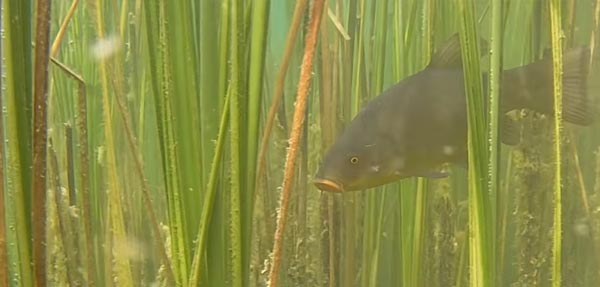
This type of fish lives in lakes and river bays with calm currents, which are abundantly filled with vegetation. It thrives in large lakes with shores overgrown with reeds and reeds. It avoids cold places with strong currents and rocky bottoms, so it cannot be found in mountain rivers and lakes.
In summer, the fish swims mainly in shallow water up to 2 m deep and with a bottom covered with silt, which is well warmed by the sun's rays. Tench prefers to live in one place, moves slightly in search of food, rummaging in silt deposits and not moving a significant distance from its habitat. You can detect it in the morning and evening by the air bubbles rising from the water when the tench eats.
Adults are usually solitary and live separately, while young fish often gather in schools. When cold weather approaches, tench stop eating, gather in flocks, and by November go into hibernation for the entire cold period.
Winter poses a threat to this fish, since with a sudden drop in water it can die in shallow water, crushed by a thick layer of ice. It is protected from low temperatures by mucus that covers the entire body.
Tench feels most comfortable when located near the bottom. He tries to avoid bright sunlight and hides in the bushes. Since it does not require large amounts of oxygen, it is able to survive in bodies of water that are unsuitable for other types of fish.
Where does tench live?
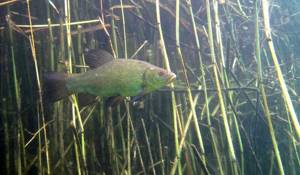
Photo: Tench in the water
On the territory of our country, tench are registered throughout its European part, partially entering the Asian spaces.
It is thermophilic, so it prefers the pools of the following seas:
- Caspian;
- Black;
- Azovsky;
- Baltic.
Its habitat occupies the space from the reservoirs of the Urals to Lake Baikal. Rarely, tench can be found in rivers such as the Angara, Yenisei and Ob. The fish inhabits Europe and Asian latitudes, where the climate is temperate. First of all, tench prefers standing water systems in regions with a warm climate.
In such places he is a permanent resident:
- bays;
- reservoirs;
- ponds;
- lakes;
- channels with weak flow.
Tench tries to avoid areas with cold water and fast currents, so you won’t find it in stormy mountain rivers. I can freely and freely molt where reeds and reeds grow, driftwood sticks on the muddy bottom, and there are many quiet pools warmed by the sun’s rays, overgrown with various algae. Most often, the fish goes to overgrown depths, staying close to steep banks.
The abundance of mud for tench is one of the most favorable conditions, because in it it finds food for itself. This mustachioed one is considered sedentary, living all his life in his favorite territory. Lin prefers a leisurely and solitary existence in the muddy depths.
Interesting fact: Lack of oxygen, salt water and high acidity are not scary for tench, so it can easily adapt to swampy water bodies and live in floodplain lakes where salty sea water has access.
Now you know where the tench fish is found. Let's find out what we can feed it with.
Features of behavior
To find food, the tench goes into the mud and digs through it. Often, in search of food, fish go deep into the aquatic thickets. Usually you cannot notice it at the surface of the water, but some fishermen note that at night, when many insects appear, it still rises to the top.
Activity during the day
Tench can feed all day, but are most active in the morning and evening, approaching the shore at this time of day. It spends most of the rest of its time at depth, where it continues to search for food. It has been noted that on cloudy days, fish often feed throughout the daylight period.
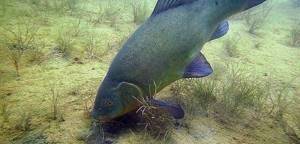
Activity by season
In spring and summer, tench live in reservoirs overgrown with vegetation, in places 1-2 m deep, well-warmed by the sun's rays. By autumn, with the approach of cold weather, it gathers in schools, which stop in one place in silt pits. In winter, activity stops: it hibernates, burrowing into the bottom silt.

You should fish only in warm weather, otherwise there will be no bite. The fishing period lasts from spring until the start of spawning, and then after two to three weeks. At this time, the tench has a strong hunger; the fish swims close to the shore, in small areas with vegetation, in search of food.
Tench breeding
Tench become sexually mature at 3-4 years, with males maturing a year earlier than females. Spawning of tench begins late, usually from the second half of May when the water warms up to at least 18°C and continues until the beginning of July. Caviar is laid in 2-3 batches on aquatic vegetation, as a new portion matures.
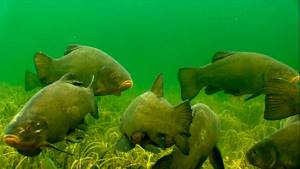
Tench spawn in scattered groups, most often on river floods and in the coastal strip of lakes, so it is difficult to see the spawning process. Tench caviar is small and greenish in color. Taking into account portioned spawning, the fecundity of the species is very high. For example, in individuals weighing up to 200 g (17-18 cm in length), absolute fertility reaches 60 thousand eggs, weighing 350 g (20-22 cm) - about 150-170 thousand, 400 g - over 300 thousand eggs.
Since tench spawning often coincides with the end of a flood, large quantities of laid eggs die from drying out and unfavorable temperature and oxygen conditions. Mature tenches are quite easily distinguished by sex. Males on spawning grounds are usually somewhat smaller and less tall-bodied than females. In addition, in males the second ray of the ventral fin is thicker, and bean-shaped subcutaneous muscular thickenings appear on the sides at the base of the ventral fins.
The incubation period for egg development is quite short (3-4 days). The first time after hatching, the larvae stick to aquatic vegetation and lead a sluggish lifestyle. After completing the resting stage, juvenile tench switches to active feeding. At the first stage, molts feed on zooplankton, but very soon they switch to consuming benthic invertebrates: insect larvae, worms, and mollusks. In addition to them, adult tenches diversify their menu with aquatic vegetation and detritus.
The tench's intestines are short (no more than the length of the body) and are not able to completely digest rough plant food. But these components are usually densely populated with bacteria, which help the fish in the digestion process. In search of food, tench dig for a long time in the bottom silt or vegetation, so feeding sites are easily detected by chains of bubbles rising to the surface.
Tench grows quite slowly, and the growth rate largely depends on the type of reservoir, food supply, temperature and climatic conditions. Typically, tench grows better in the south of the country than in the northern regions. Under natural conditions, by the end of the first year of life, tench reaches 2.5-4 cm in body length, the second - up to 8, and the fifth-sixth - up to 18-20 cm. Males grow somewhat slower than females. The maximum dimensions of tench are up to 60 cm in length and, as an exception, up to 7.5 kg in weight.
In conditions of high-nutrient ponds, the growth rate of tench can increase significantly. According to A.S. Vavilov (1955), in ponds under appropriate conditions, tench already in the first summer reaches a mass of 50 g, at the age of two - 250 g, at the age of three - 800 g, at the age of seven - 1500 g. The question arises, why at such High fertility and undemanding to living conditions, tench remains a rare fish.
There are several reasons, but the main one is high mortality in the initial stages of life. As already noted, a significant part of the eggs and larvae may die due to a discrepancy between the timing of spawning and the timing of the flood. Juvenile tench grow very slowly, so for a long time they remain prey not only for predatory fish, but also for aquatic vertebrates. For the same reason, offspring from late spawning have difficulty surviving a long winter, because does not have time to gain the appropriate weight. During wintering, the skin of adult tenches is often affected by ectoparasites (fungi and protozoa), which also affects the size of the herd. Nevertheless, the tench shows an enviable adaptability to life, remaining constant in its preferences.
Diet
Most of the fish's diet consists of animal food, but from time to time they feed on young vegetation. Tench prey on invertebrates living in the reservoir: insects and their larvae, small mollusks and crustaceans, bottom worms. Can eat mosquito larvae. In spring, it eats algae, young shoots of sedges and reeds growing near the shores. In general, these fish are unpretentious and will eat anything they can find.
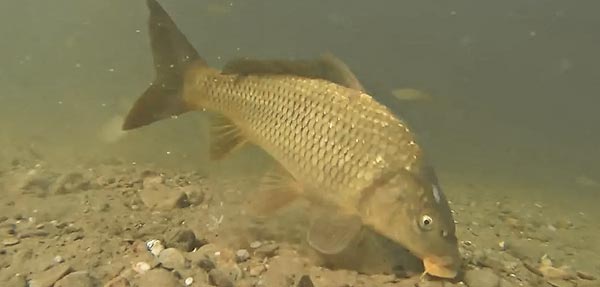
Tenches feed mainly in bottom areas with a muddy bottom, in thickets. To get food, they dig up the bottom. In the fall, they need less food than in the summer, and in the winter, while hibernating, they completely stop eating. After awakening, they migrate close to the shores in search of food.
What do fish eat in the wild?
The diet is based on plant foods, zooplankton and small living organisms that inhabit the bottom of reservoirs:
- bloodworms, amphipods, rotifers;
- Cyclops, Bosmina, Polyphemus;
- bedbugs, annelids, mollusks, leeches;
- larvae of chironomids, mayflies, dragonflies, caddisflies, lampreys;
- water beetles (lamella beetles, diving beetles);
- shoots of telores, pondweed, buttercup, hornwort, elodea;
- duckweed, other small floating plants;
- cereals, phytoplankton, detritus.
Molt fish willingly eat artificial baits and mixed feed, which are intended for catching and growing other carp-like fish. When there is a shortage of food, it can feed on fry, winged insects, tadpoles, eggs, and other specific animal foods. The main feeding activity occurs at dusk and is accompanied by deep digging of bottom sediments. If the water temperature drops below +10°C, the fish loses its appetite and stops looking for food. The same situation is typical for a very heated environment (above +30°C), which causes thermal stupor.
To learn more:
The royal fish of the sturgeon family - sterlet
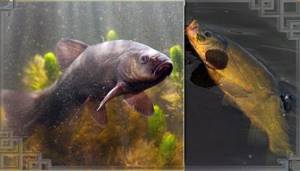
The process and features of reproduction
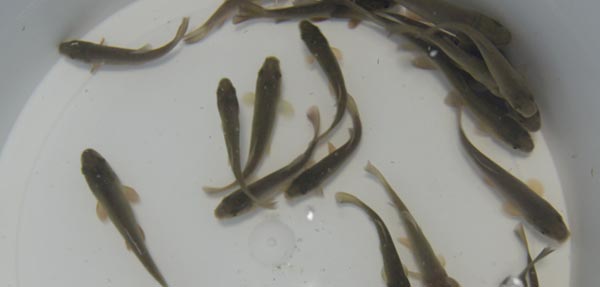
Tench is thermophilic and spawns quite late, usually closer to the beginning of summer. This happens when the water warms up to a temperature of 19-20 degrees. For spawning, it chooses shallow places with little current, which are well protected from the winds and are abundantly overgrown. Reproduces individually, without gathering in a flock. The laying is done at a depth of 30 to 80 cm; it is often fixed on branches of bushes or trees growing along the shore lowered into the water.
Caviar throwing occurs several times, the break ranges from 10 days to two weeks. Fish that are 3-4 years old and have reached puberty take part in spawning. Only those individuals whose weight is more than 200-400 g can reproduce. During the season, tench can lay up to 500 thousand eggs, their maturation occurs in 3 days. Caviar develops very quickly, but this does not contribute to the same rapid increase in the number of fish. This is due to the fact that most of it is destroyed by waterfowl and other fish, and most of the juveniles become food for burbot.
The length of the fry immediately after hatching is no more than 3.5 mm. They attach to the substrate and remain in this place for several days. The larva feeds on the nutrients remaining in the yolk sac and rapidly increases in size.
When tench fry begin to swim on their own, they gather in schools and take refuge in dense vegetation, feeding on plankton and algae. When their length reaches 1.5 cm, the young animals sink to the bottom and begin to eat more nutritious food, which consists of benthic organisms.
Gastronomic qualities
A popular proverb says: “the best meat is pork, the best fish is linina.” This is a real fact that any person who has at least once tasted a dish from this unique representative of freshwater ichthyofauna will agree with. The fish has juicy and moderately fatty meat (3.5-3.8%) with a sweetish aftertaste, the ratio between edible and waste parts of the body is 55-60%.
Tench fillet is not bony, is quickly absorbed by the body, and is suitable for dietary nutrition due to its moderate fat content (3.5-3.8%) and low calorie content (40-45 kcal per 100 g). In addition, regular consumption helps reduce blood sugar levels. The fish is rich in:
- vitamins A, C, E, PP, B2, B6, B12;
- iodine, fluorine, phosphorus;
- potassium, calcium, manganese;
- polyunsaturated fatty acids.
Useful properties of tench fish
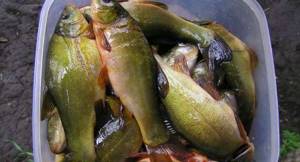
Do not assume that freshwater fish are not able to benefit the human body.
- For example, regular consumption of tench fish meat helps a person:
- Improve the functioning of the gastrointestinal tract (especially the stomach itself);
- Improve the functioning of the thyroid gland (by the way, only marine fish representatives can do this);
- Get rid of unpleasant arrhythmia;
- Strengthen the heart muscle;
- Reduce excess weight due to a small amount of calories;
- In general terms, establish the correct functioning of all internal organs.
Varieties of tench
There are 4 ecological variations of this fish depending on the place where they live. Lines differ slightly in body structure and scale color. You can find the following varieties:
- Dwarf . It is small in size - up to 12 cm in length. This is due to the fact that the fish lives in overcrowded water bodies, which is why its growth is slowed down. This species is the most common compared to others and can live in almost any fresh water body.
- River . Lives in bays and river channels where slow water movement is observed. It is distinguished from other varieties by its significant thinness. May have an upward curved mouth.
- Ozerny . Outwardly it looks like a river fish, but is larger in size. Settles in spacious lakes and reservoirs.
- Prudovaya . It lives in small bodies of water and has a thinner body than the lake one. If you add it to a large lake, it will begin to increase in size quite quickly.
Origin of the species and description
Photo: Lin
Tench is a species of ray-finned fish belonging to the carp family and the order Cypriniformes. It is the only representative of the genus of tenches of the same name (Tinca). From the name of the fish family it is clear that the carp is the closest relative of the tench, although you can’t immediately tell from their appearance, because at first glance there is no similarity. Microscopic scales with a golden-olive hue and an impressive layer of mucus covering them are the main distinguishing features of tench.
Interesting fact: When a line is removed from water, the mucus dries quickly and begins to fall off in whole pieces, giving the impression that the fish is molting, shedding its skin. Many believe that this is why she was called that.
There is another assumption regarding the fish name, which characterizes its way of life. The fish is inert and inactive, so many believe that its name is associated with the word “laziness,” which later acquired such a new meaning as “tench.”
Video: Lin
In natural conditions, tench is not divided into separate varieties, but there are a couple of species that people have bred artificially, these are the golden tench and the Kwolsdorf tench. The first one is very beautiful and similar to a goldfish, so it is often stocked in decorative ponds. The second one is identical in appearance to ordinary tench, but grows much faster and has significant dimensions (one and a half kilogram fish is considered standard).
As for the ordinary tench, created by nature itself, it can also reach impressive sizes, reaching a length of up to 70 cm and a body weight of up to 7.5 kg. Such specimens are rare, so the average length of a fish body varies from 20 to 40 cm. In our country, fishermen most often catch tench weighing from 150 to 700 grams.
Some subdivide tench relative to the bodies of water where they live, highlighting:
- lake tench, which is considered the largest and most powerful, favors large lakes and reservoir areas;
- river tench, which differs from the first in its smaller size, the mouth of the fish is raised upward, inhabits river backwaters and bays;
- pond tench, which is also smaller than lake tench and thrives in both natural standing reservoirs and artificial ponds;
- dwarf tench, which settles in stocked reservoirs, which is why its dimensions do not exceed a dozen centimeters in length, but it is the most common.
Tench fishing
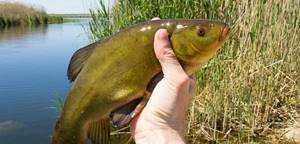
Tench moves little and is picky about baits, so catching it often becomes quite difficult. But fishing can turn into an interesting activity if you learn about the behavior of fish in a particular lake or pond.
Summer fishing
Summer is the main time to fish, as the fish are most active. Taking into account its feeding characteristics, it is caught using two types of gear: bottom and float rods. The last option is attractive because it gives an excellent catch. If you choose a bottom fishing rod, it is better to give preference to the feeder variety. If the surface of the bottom of the reservoir is hard, the nozzle should be lowered to the very bottom, and if it is muddy, it should be kept a little higher.
In tench habitats, aquatic vegetation may be too dense and do not allow free fishing. In such cases, using a rake, the area for throwing bait is cleared and a path is made for fishing. The bait is thrown onto the cleared space.
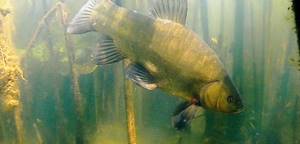
When the open water season begins, tench consume animal food, so maggots, bloodworms, and worms can be used for bait. After some time, when shoots of aquatic vegetation (reeds, pondweed, egg capsules) appear, the food becomes more varied. At this time, fish can be caught on soft leaves or pieces of shoots. Tench can be caught well with a crayfish neck. If it is immersed correctly, such a nozzle is clearly visible against the background of the muddy bottom and is a tasty morsel. You can also use shelled snails or slugs.
An excellent catch with plant bait can be obtained towards the end of summer; pearl barley, peas or dough are used for this. Tench also loves cottage cheese. Many fishermen claim that when this product is added to other bait, the catch becomes much more abundant.
To attract tench to the fishing spot, you can use conventional bait mixtures. Since this fish tends to move in the same places, it is fed over several days. To do this, use bread, porridge, boiled potatoes, and crushed worms. If there is accurate information about where the tench lives, there is no need for bait.
The best time for fishing is from sunrise to 10 am, and then in the evening, before sunset. The change in weather significantly affects the bite. If the atmospheric pressure drops significantly, it may stop completely. It is best to fish in cloudy, warm weather with light drizzle. After rain, the fish usually rises closer to the surface, which must be taken into account when calculating the depth of lowering the nozzle.
In winter
Tench does not show much activity in winter, but during prolonged warm weather, if the water is well saturated with oxygen, it can emerge from hibernation and go in search of food. Since this happens quite rarely, it is easy for anglers to miss such moments. Therefore, it is considered great luck if in winter you manage to catch a tench on a hook. There are some amateurs who purposefully go after tench in the cold season, but the catch is usually modest.
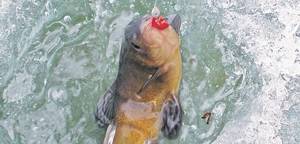
Tench fishing
The optimal time for fishing is the pre-spawning period (April-May) and moderately warm August, September, October. You need to go out to the pond while it’s still dark so as not to miss the morning bite. As a universal tackle, a float fishing rod is used, which is equipped with:
- a small spinning reel (1500-2000);
- main line of dark color (0.25-0.3 mm);
- leash 20-25 cm long (thickness 0.18-0.22 mm);
- a fast action rod 4-5 m long;
- float with a load capacity of 3-5 g;
- an olive-shaped sinker (2-4 g) and a padding (1-3 g);
- crochet No. 8-14 (according to international classification).
The fairly large thickness of the equipment is not related to the weight of the fish, but to the fishing location, where plants and snags abound. The choice of float, which should have a dim color (brown, green, blue, dark green), deserves attention. Large earthworms, dung worms, leech, bunch of bloodworms, caterpillars, and maggots are used as catchable baits for tench.
Large specimens are often caught by dragonfly larvae, but here you need to be prepared for possible bites from perch and carp. Among the vegetable attachments, the leaders are wheat grains, oats, pearl barley, peas, potatoes, dough, semolina, and bread crumb. In some reservoirs, bait is successfully used in the form of a cube of cake tied with threads with sides of 1x1 cm or 1x1.5 cm (hemp, flax, sunflower). If the link bite is unstable, it is advisable to combine baits on the hook, creating a “sandwich” of maggots and bloodworms, corn and dough. Another way of fishing for tench is bottom tackle with a rubber shock absorber. You can bring it by swimming or by boat out of a window among dense thickets and catch fish without the risk of unsuccessful casts.
To learn more:
Pike perch: habits of sea and river species
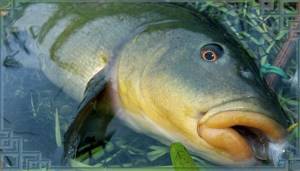
Biting and fishing
This type of fish is usually wary of bait, but there are periods of excessive activity and the fishing is fast. The bite is reminiscent of crucian carp, with the difference that tench likes to “delay the process” for several minutes: first, he carefully plucks the bait, throwing its particles to the bottom. This can be seen by the long oscillations of the float, which fishermen often confuse with biting small fish. There is no need to hook at such moments - this is done when the float sharply deepens and begins to float to the side or lies on one side.
Disappearances are rare, since usually the hook completely cuts through the mouth. The caught fish will splash for a long time, trying to go into the silt or thickets. Therefore, when fishing, you should be persistent, and if the tench does enter the thickets, you need to pull the line a little and wait until he decides to come out of his hiding place. When the tench gets tired, it is carefully brought to the surface of the water near the shore, not allowing it to splash - this can scare away other individuals hiding nearby.
When fishing, you should not rush to hook, especially if large baits are used. Tench has a good sense of smell and touch, which helps it in searching for food and quickly finding bait. They remove the fish from the water using a net so that it does not slip out due to the mucus covering the body.
Selling tench: how to prepare for doing business
Until the middle of the 20th century, tench was actively bred in Russia along with carp and crucian carp, but today it is grown as an auxiliary commercial fish. The breeding characteristics of these species are generally similar.
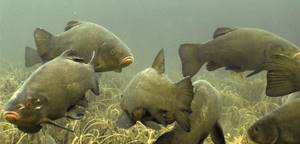
The most difficult is the initial stage, at which it is necessary to go through administrative barriers. You can dig an artificial reservoir on your own or rent one that is already available from the state. In both the first and second cases, you need to obtain special permits.
When choosing a reservoir or territory for its creation, you need to take into account several factors for favorable breeding. Tench loves silted ponds with abundant vegetation. Small, stagnant ponds are not suitable for it.
In order for the business to progress successfully, you need to choose an object with an area of over 20 hectares. If there are no financial restrictions, more is possible. In large ponds, entrepreneurs not only breed fish for sale, but also provide fishermen with the opportunity to fish for a fee. The latter option will be especially profitable if the reservoir is located near a city or large village.
When choosing a pond, you need to take care of the water drainage system: the sluice will not only maintain the desired level, but will also be the simplest way to catch commercial tench. If it is not possible to equip a drain, you should abandon such a reservoir and find another one.
Tench need a well-silted bottom and extensive vegetation, and the water depth must be more than 1.5 m to provide safe conditions for hibernation. Since during extensive breeding the diet of fish includes small invertebrates living in silt and aquatic vegetation, the entrepreneur does not need to spend money on maintaining a pond. This method is only suitable for large reservoirs with low fish numbers.
To increase the volume of goods from such a pond, an intensive breeding method should be used, in which artificial complementary foods become the main component of the diet. For breeding, you need to purchase fry, which are released into the water in the spring and caught for sale in the fall. One hectare of pond with intensive cultivation can produce several tons of products, but the costs will also be quite high. For feed, you can use compound feed, fresh vegetables mixed with porridge, weed seeds and grain waste.
Where and how to catch tench
Interest in tench is also constant. Because of its tasty and low-boned meat, tench has always been a desirable catch for fishermen of all times. In some places, the meat, internal organs and mucus of tench are considered medicinal and are used in folk medicine. There are beliefs that fish also use tench mucus for treatment. The latter is most likely from the realm of fantasy, but it makes this fish extraordinary. Economic interest is another matter.
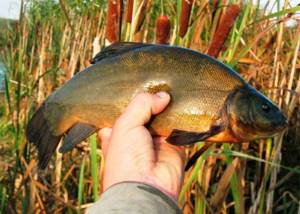
In European countries and here, tench, along with carp, crucian carp and ide, was among the first to be bred in ponds. In the Czech Republic and Germany, commercial cultivation of tench is still considered economically profitable due to the increased demand for products on the domestic market. Even for the needs of aquarists, through artificial selection, a golden form of tench, similar to a goldfish, was bred. Tench is grown in small quantities in pond farms in Belarus both for the purpose of resettlement and commercial cultivation.
Growing for sale
Fish breeding begins with fry, which are sold by numerous fish hatcheries. When purchased, such young fish weigh 30-40 g, by the second year of life their weight reaches 200 g, and by the third - 400 g. The latter figure is considered optimal for commercial fish. From 1 hectare you get approximately 1.2 tons of tench. If it is grown in a political culture with carp, productivity increases to 1.5 tons.
In small ponds, catching is not difficult, since tench are quite lazy and do not move away from the main place of food. The easiest way to catch it is with dragnets. But for spacious reservoirs the method is not suitable, since using a drag net it will not be possible to cover the entire territory. The best option is to drain the water. It is carried out at night, and it is advisable to create as little noise as possible to avoid burying the line in muddy soil.
One of the advantages of tench for business is its unpretentiousness. It can survive without water for up to two days, so transporting it is not a problem.
Breeding profitability
The profitability of fish farming can vary significantly and depend on the conditions in which the fish are raised, so it is difficult to accurately calculate the average income. In addition, in Russia it is rare to meet businessmen who are exclusively engaged in the cultivation of tench. Most often it is bred with carp. Therefore, the average costs that will be required to run such a farm will be considered.
- To prepare a reservoir with an area of 100 hectares, an average of 5-7 million rubles is needed. The amount includes digging a new artificial reservoir and building a sluice. If you rent a pond from the state, the costs will be much lower.
- It is necessary to purchase fry: to fill a reservoir with an area of 100 hectares it will take approximately 2-3 million rubles. If fish are planned to be caught every fall, such costs will be annual. You can let reproduction take its course by lowering the catch rate. In this case, a situation is possible in which spawning will cover the population decline from fishing. This means that you will no longer need to fill the reservoir with new fry.
- If an entrepreneur chooses an intensive breeding method, he will have to spend money on buying feed. Agricultural waste is used for these purposes. You can reduce costs by agreeing on direct wholesale purchases with farmers who are always ready to bargain when purchasing large volumes of products.
- To ensure order in the reservoir and to protect it from poachers, it is necessary to hire security. Her salary is also included in the list of expenses.
- You need to pay for the services of catching fish and transporting it to sales points.
The cost of 1 kg of intensively grown fish is approximately 70 rubles. per kilogram. If an extensive method is chosen, the figure will be much lower. You can sell frozen tench wholesale for about 100 rubles. for 1 kg, live - for 120-140 rubles. If you sell retail, your revenue will be several times higher. Thus, from 1 kg of fish the net profit will be about 30-40 rubles. (the exact figure depends on the cost, the wholesale price at a particular time and the method of sale).
Since an entrepreneur receives about 1.2 tons of fish from 1 hectare of reservoir when breeding using an intensive method, then from a pond with an area of 100 hectares, one can receive about 3.5 million in net profit. This income can be increased by organizing paid fishing. For example, in the reservoirs of the Moscow region, a fisherman needs to pay several thousand rubles for 1 day. If 10 fishermen visit the pond every day, income increases by 10-20 thousand rubles. in a day.
What does tench look like?
Tinca tinca is unlike any other representative of the ichthyofauna, both in the native carp and in distant families. Famous naturalists L.P. Sabaneev and S.T. Aksakov pointed out in his works that “the tench is similar in shape to the ide.” If these common features exist, they are visually inaccessible to the average person, at the same time, the unusual exterior of the fish allows it to be unambiguously identified among other species, if you pay attention to the following morphological characteristics:
- thickened tall body;
- very small, tightly seated cycloid scales (87-105 pieces in the lateral line);
- small eyes with red irises;
- wide truncated caudal peduncle;
- terminal small mouth with fleshy lips;
- a pair of sensitive antennae up to 2 mm long on the sides of the upper jaw;
- rounded dark fins;
- sloping sides covered with a continuous layer of mucus.
The color scheme depends on the living conditions. In a clean pond with light soil, the body has a greenish-silver color with thicker tones in the back area. In the case of a muddy bottom, the shades shift to a cool dark brown spectrum, often with an olive tint. There is a decorative form of fish - golden tench, which differs from the basic taxon in its saffron-amber color, dark spots on the sides and black irises.

The origin of the species name is associated with one of the unique morphological features. The mucus that envelops the body, when exposed to air, quickly dries out, hardens and falls off in pieces, reminiscent of the process of changing the coat of animals - molting.
The fish is characterized by well-developed secondary sexual characteristics, which are especially noticeable in males - enlarged ventral fins with thickened rays.
To learn more:
White carp: description of the fish and methods of catching it
Eating tench
The most delicious meat comes from individuals caught in late April - early May. While spawning lasts, fish are not caught or eaten. Tench has a specific aroma that many people do not like. It is due to the fact that the fish lives in fresh water bodies with a marshy bottom, so its meat gives off a little silt. There is a solution to this problem: you need to place living individuals in clean water for 10-12 hours. If this method does not help to completely get rid of the smell, use lemon juice and various spices.
Before cooking, you need to clean the tench from its scales. The husk must be removed in such a way that the skin underneath is not damaged. Then, when frying or baking, it forms an appetizing crust.
Tench is a versatile fish that can be used for boiling, frying, baking, marinating, making fish soup and aspic. Its fillet makes an excellent filling for various dishes. Carcasses can be deliciously cooked in wine or sour cream; they are stuffed and baked with herbs. Many people prefer to eat tench only baked: when cooked in this way, its meat becomes especially soft and juicy. Before putting in the oven, the fish must first be marinated in lemon juice and aromatic herbs, and then several sprigs of fresh dill should be placed in the cut belly.
Gastronomic features
Before cooking this fish, you need to get rid of the mucus. You need to rinse the carcass well under running cold water, pour boiling water over it, and rinse again. In this case, the mucus will coagulate and be easily removed. You can easily get rid of the smell of mud by soaking the fish in a saline solution.

Like all representatives of cyprinids, tench is a bony fish. Therefore, it is worth choosing specimens as large as possible. When cleaning it, you should carefully remove the gallbladder without damaging it. Otherwise, the meat will acquire an unpleasant bitterness and will be unedible.
Many tasty, dietary and, at the same time, nutritious dishes can be prepared from tench. The meat of this fish has a sweetish taste and is excellent for frying, baking in the oven, preparing aspic and fish soup.
Catching tench is an exciting activity, similar to a difficult but interesting quest. Catching this cunning and cautious loner is a great success. And a dish prepared from this fish is a real pleasure for a true gourmet.
Properties of mucus
The tench's body is covered with a layer of mucus, which has medicinal properties and is a natural antibiotic. Scientists have conducted studies in which it was found that in case of illness, various fish swim to healthy tenches and rub against their sides, which are covered with mucus. This allows them to protect themselves from parasites living in the water. It is noted that the tench will allow even a sick pike to approach him for such “treatment”, which will not attack him. Most predators do not perceive tench as food at all, most likely due to the same mucus that completely covers it. Mucus ensures survival during winter, when the fish hides in the mud from the cold.
The name tench is also associated with the presence of this substance. When the fish is taken out of the water, the mucus begins to darken as it dries and the color changes. Then it begins to fall off in pieces, and in these places only light scales remain. To put it another way, the fish molts.
What does tench eat and what is used to catch it?
Tench is omnivorous and feeds on both food of animal origin and aquatic vegetation. They do not shun invertebrates, water bugs, dragonfly larvae, and fry. They suck the shoots of duckweed, cattails, and water lilies, and willingly eat some cereals. They feed according to a schedule - at dawn and at dusk. At night they rest on the soft bottom, and on a hot day they climb into the very thick of the algae. In dense grass, tench find shelter from light, comfortable water temperature and food.
Catching a freshwater lump is very difficult, but resourceful fishermen resort to a wide variety of tricks. Tench is caught using bottom gear and float fishing gear. Even gastronomic delights in the form of chopped maggots with corn in dough are suitable as bait.
